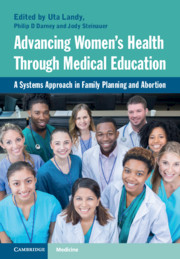 Advancing Women's Health Through Medical Education
Advancing Women's Health Through Medical Education Book contents
- Advancing Women’s Health Through Medical Education
- Reviews
- Advancing Women’s Health Through Medical Education
- Copyright page
- Dedication
- Contents
- Contributors
- Preface
- Acknowledgments
- Introduction
- Section I Abortion Training: Workforce, Leadership, Social & Political Impact
- Section II Integration of Abortion into Graduate Medical Education
- Section III Family Planning Curricular Design & Implementation
- Chapter 17 A Guide for Creating a Program in Sexual and Reproductive Health-Care Education
- Chapter 18 Creating and Implementing a Curriculum for Reproductive and Sexual Health Training Programs
- Chapter 19 Assessing Competence in Family Planning Skills through Milestones
- Chapter 20 Educating and Mentoring Medical Students in Family Planning
- Chapter 21 The Role of Students in Advocating for Training in Sexual and Reproductive Health Care
- Chapter 22 The Role of Simulation in Sexual and Reproductive Health-Care Training
- Chapter 23 The Benefits of and Strategies for Supporting Residents’ Partial Participation in Abortion Training
- Chapter 24 Stigma and Abortion Care
- Chapter 25 Emotional Support
- Section IV Reproductive Health Services & Abortion Training: Global Examples
- Index
- References
Chapter 18 - Creating and Implementing a Curriculum for Reproductive and Sexual Health Training Programs
from Section III - Family Planning Curricular Design & Implementation
Published online by Cambridge University Press: 30 July 2021
- Advancing Women’s Health Through Medical Education
- Reviews
- Advancing Women’s Health Through Medical Education
- Copyright page
- Dedication
- Contents
- Contributors
- Preface
- Acknowledgments
- Introduction
- Section I Abortion Training: Workforce, Leadership, Social & Political Impact
- Section II Integration of Abortion into Graduate Medical Education
- Section III Family Planning Curricular Design & Implementation
- Chapter 17 A Guide for Creating a Program in Sexual and Reproductive Health-Care Education
- Chapter 18 Creating and Implementing a Curriculum for Reproductive and Sexual Health Training Programs
- Chapter 19 Assessing Competence in Family Planning Skills through Milestones
- Chapter 20 Educating and Mentoring Medical Students in Family Planning
- Chapter 21 The Role of Students in Advocating for Training in Sexual and Reproductive Health Care
- Chapter 22 The Role of Simulation in Sexual and Reproductive Health-Care Training
- Chapter 23 The Benefits of and Strategies for Supporting Residents’ Partial Participation in Abortion Training
- Chapter 24 Stigma and Abortion Care
- Chapter 25 Emotional Support
- Section IV Reproductive Health Services & Abortion Training: Global Examples
- Index
- References
Summary
A curriculum in reproductive and sexual health (SRH) serves as the foundation on which the learner builds and integrates knowledge in the family planning field.In the United States, accreditation organizations at all levels of medical education require written curricula with clearly defined educational objectives, methods, and evaluations to address core competencies in health care delivery. In this chapter, the authors describe a rigorous framework for developing a curriculum in sexual and reproductive health, beginning with conducing a general and targeted needs assessment, defining goals and objectives, outlining educational strategies, implementing the curriculum and collecting evaluation and feedback. Readers will have the tools they need to create a SRH curriculum in their own institution.
Keywords
- Type
- Chapter
- Information
- Advancing Women's Health Through Medical EducationA Systems Approach in Family Planning and Abortion, pp. 183 - 189Publisher: Cambridge University PressPrint publication year: 2021
